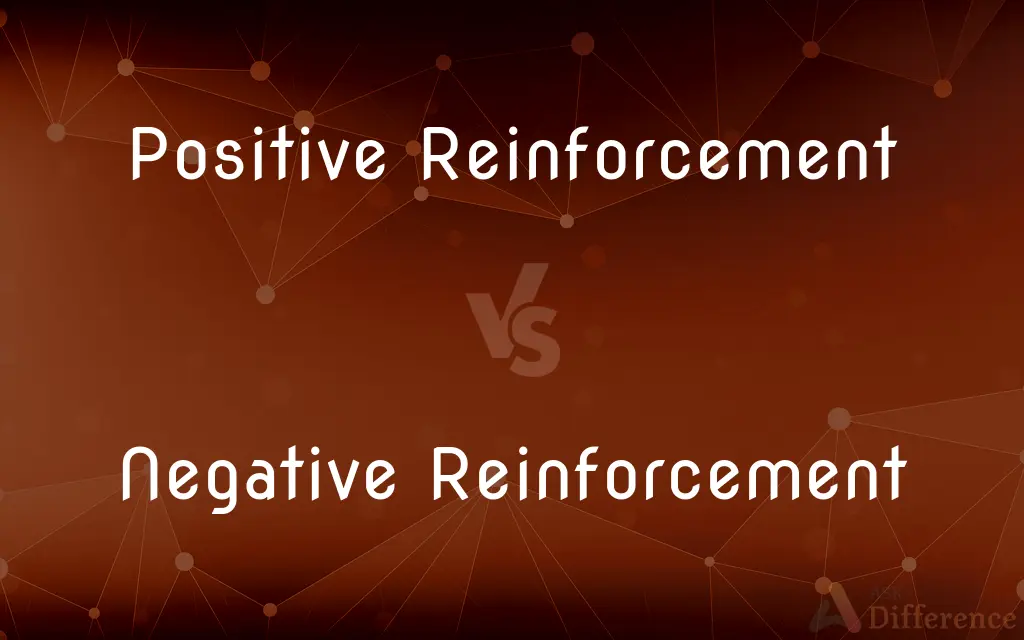Positive Reinforcement vs. Negative Reinforcement — What's the Difference?
By Tayyaba Rehman — Published on October 7, 2023
Positive Reinforcement adds desirable stimuli to increase behavior, while Negative Reinforcement removes undesirable stimuli to increase behavior. Both reinforce and increase the likelihood of a behavior.

Difference Between Positive Reinforcement and Negative Reinforcement
Table of Contents
ADVERTISEMENT
Key Differences
In the realm of psychology, especially within behavior modification strategies, Positive Reinforcement is pivotal. Positive Reinforcement involves the addition of a favorable stimulus following a behavior, with the intention to increase the frequency of that behavior. An elementary example of Positive Reinforcement is praising a student to encourage the repetition of good behavior.
Conversely, Negative Reinforcement is not about punishing or introducing an adverse stimulus. It refers to the removal of an unpleasant stimulus to enhance the likelihood of a behavior reoccurring. To illustrate, when a student behaves well, a teacher might excuse them from doing an undesirable task, thereby increasing the probability of the good behavior reoccurring.
A crucial aspect of Positive Reinforcement is that it generally employs stimuli perceived as rewarding or pleasant by the recipient. In a work environment, for instance, a bonus is a form of Positive Reinforcement that employers utilize to encourage employee productivity and loyalty.
Negative Reinforcement often leverages an existing, undesirable situation to boost a behavior. For instance, an office manager might mitigate strict supervision (an undesirable stimulus) when an employee consistently demonstrates reliability and responsibility, aiming to promote these behaviors.
It's vital to recognize that Positive Reinforcement and Negative Reinforcement both aim to enhance the probability of a behavior being repeated, albeit through different mechanisms. Positive adds something desired; Negative takes away something undesired. Both techniques are prevalent in various scenarios, including educational settings, workplaces, and behavioral therapies, to foster desirable habits and behaviors.
ADVERTISEMENT
Comparison Chart
Definition
Adds a positive stimulus.
Removes a negative stimulus.
Purpose
To increase behavior.
To increase behavior.
Example
Giving a treat when a dog sits.
Removing noise when a desired action occurs
Application in Learning
Used to reward correct answers.
Used to stop an aversive stimulus.
Emotional Response
Often associated with pleasure/reward.
Often associated with relief.
Compare with Definitions
Positive Reinforcement
Positive Reinforcement is constructive in nature.
Offering extra playtime encourages children to finish tasks quicker.
Negative Reinforcement
Negative Reinforcement seeks to promote behavior.
The dog stops whining when given attention.
Positive Reinforcement
Positive Reinforcement involves rewarding behavior.
The teacher gave stickers to students who completed their homework.
Negative Reinforcement
Negative Reinforcement strengthens behavior.
The headache fades after taking pain relief, encouraging its future use.
Positive Reinforcement
Positive Reinforcement aids in establishing habits.
Regularly rewarding gym attendance facilitates a consistent exercise routine.
Negative Reinforcement
Negative Reinforcement involves a stimulus removal strategy.
The nagging ceases once the chores are done.
Positive Reinforcement
Positive Reinforcement enhances the recurrence of behavior.
Praising a child for tidying their room encourages them to do it again.
Negative Reinforcement
Negative Reinforcement eliminates an unpleasant stimulus.
The beeping stops when you fasten the seatbelt.
Positive Reinforcement
Positive Reinforcement utilizes pleasant stimuli.
Employees received bonuses for reaching their sales targets.
Negative Reinforcement
Negative Reinforcement utilizes aversive conditions.
Disabling pop-up ads after purchasing the premium version.
Common Curiosities
Is positive reinforcement always effective?
While often effective, its success can depend on the individual and the appropriateness and timing of the reinforcing stimulus.
Can positive reinforcement lead to dependency?
Yes, there’s a risk that individuals may become dependent on external rewards and not internalize the desired behavior.
Is positive reinforcement applicable to all age groups?
Yes, it can be utilized across all age groups, adapting the reinforcing stimuli to be age-appropriate.
Can positive reinforcement be used in all settings?
Yes, it can be applied in various settings, including at home, in schools, and within workplaces to encourage desired behaviors.
Which is generally more effective – positive or negative reinforcement?
Research often suggests that positive reinforcement tends to be more effective and healthier for sustaining long-term behavior change.
What is positive reinforcement?
Positive reinforcement involves adding a favorable stimulus to increase the likelihood that a desired behavior will be repeated.
Is negative reinforcement suitable for all environments?
While it can be applied in various environments, care must be taken due to the potential for unintended psychological effects.
Is negative reinforcement effective in the long term?
Its long-term effectiveness can vary and may be less sustainable if individuals become adapted to the removal of the negative stimulus.
Does negative reinforcement involve punishment?
No, negative reinforcement is not about punishment but about increasing a behavior through the removal of a negative condition.
Can negative reinforcement have negative side effects?
Yes, it can potentially lead to stress or anxiety if the negative stimulus is perceived as threatening or unpleasant.
Can positive and negative reinforcement be used together?
Yes, they can be used concurrently or sequentially, depending on the behavioral objectives and individual circumstances.
How should one choose between positive and negative reinforcement?
Consideration of the individual, the desired outcome, and the potential impacts should guide the choice, often with a preference towards positive approaches when possible.
What is negative reinforcement?
Negative reinforcement involves removing an unfavorable stimulus to increase the likelihood that a desired behavior will occur.
Are there ethical considerations in choosing between the two?
Yes, considering the individual's well-being, emotional state, and the potential impacts of the reinforcements is crucial in ethical application.
Are positive and negative reinforcement opposites?
Not exactly. Both aim to increase desired behaviors, but positive reinforcement adds a positive stimulus, while negative reinforcement removes a negative one.
Share Your Discovery

Previous Comparison
Articles vs. Determiners
Next Comparison
Analog Signals vs. Digital SignalsAuthor Spotlight
Written by
Tayyaba RehmanTayyaba Rehman is a distinguished writer, currently serving as a primary contributor to askdifference.com. As a researcher in semantics and etymology, Tayyaba's passion for the complexity of languages and their distinctions has found a perfect home on the platform. Tayyaba delves into the intricacies of language, distinguishing between commonly confused words and phrases, thereby providing clarity for readers worldwide.
















































